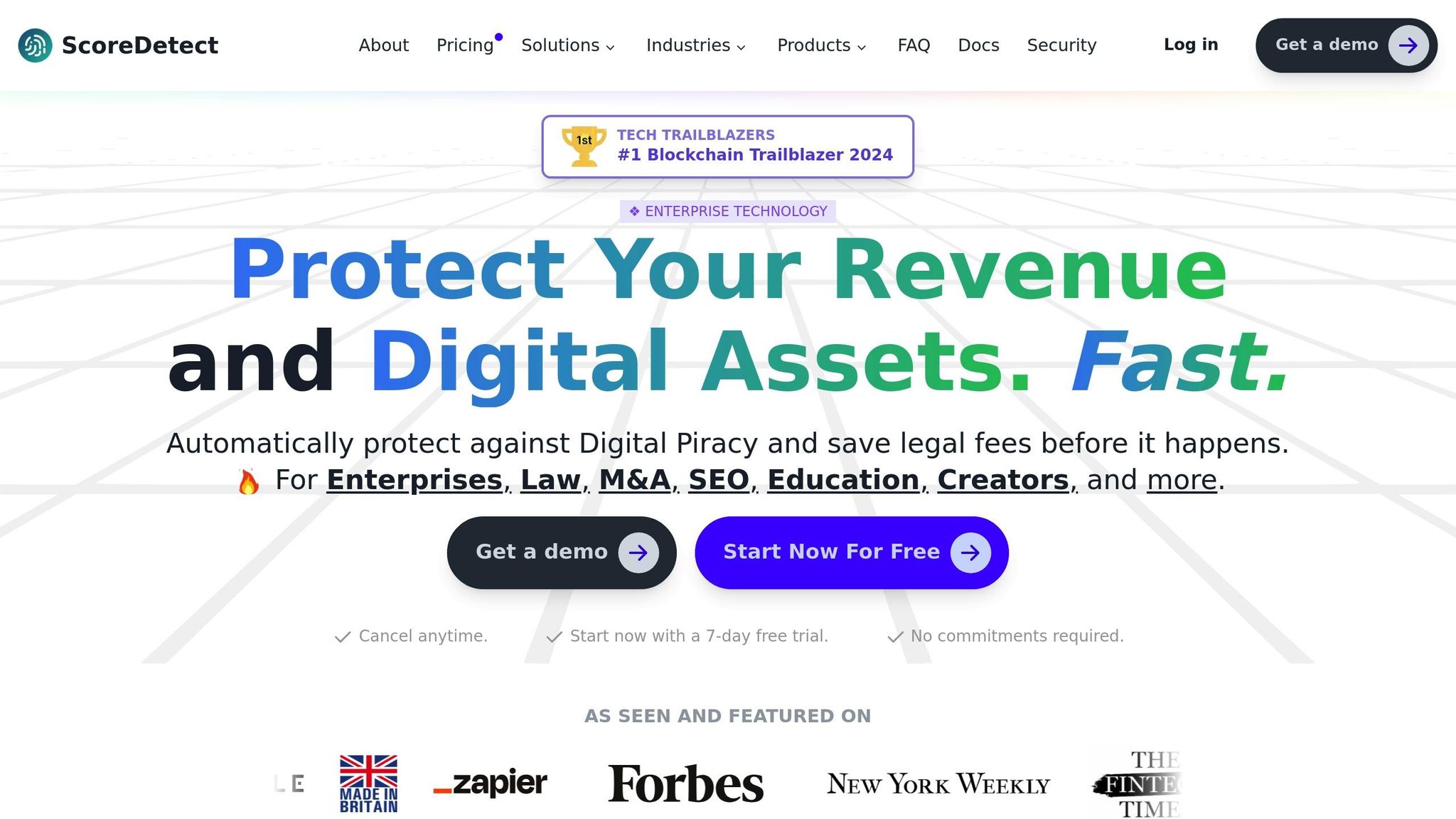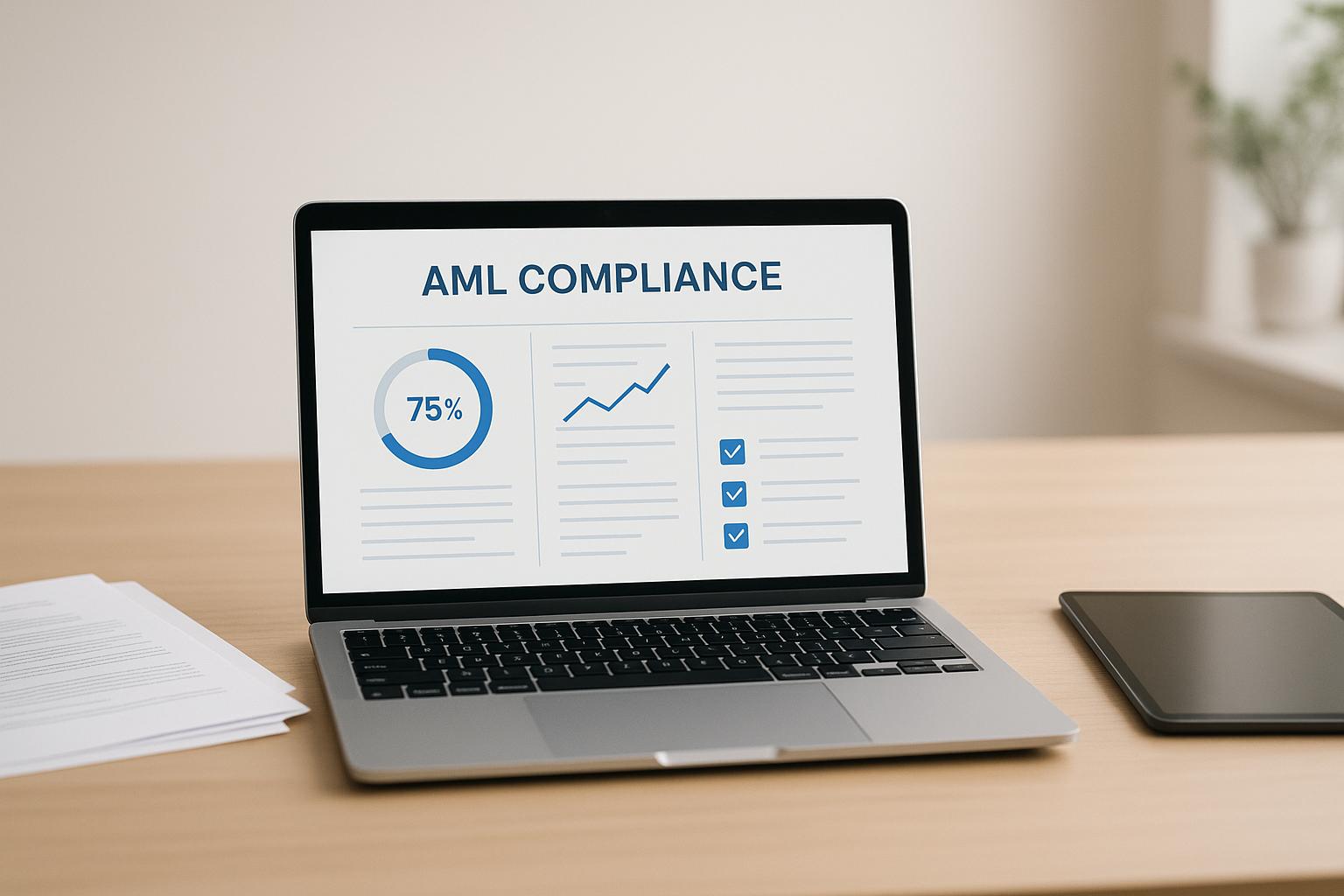Tamper detection ensures the integrity of digital content by identifying any changes after its creation. It uses methods like cryptographic hashing, digital signatures, and blockchain verification to safeguard files such as documents, images, and videos. This technology is critical for maintaining data security, preventing misuse, and complying with legal standards like the ESIGN Act.
Key Highlights:
- What It Does: Detects changes to digital files and ensures content integrity.
- How It Works: Uses cryptographic hashing to generate unique "fingerprints" for files, which reveal any modifications.
- Why It’s Important: Protects sensitive data, supports legal compliance, and prevents costly breaches ($4.45M average per incident).
- Implementation Steps: Register content, apply security layers, and set up monitoring with alerts.
- Challenges: Requires careful integration, minimizes false alerts, and adapts to emerging threats like quantum computing.
Example Solution: Tools like ScoreDetect combine AI, blockchain, and invisible watermarking to protect content, detect misuse, and issue takedown notices with high success rates. These systems are essential for industries like law, finance, and healthcare where data integrity is critical.
Tamper detection not only secures digital assets but also ensures compliance with strict regulations, making it a key part of modern cybersecurity strategies.
Understanding Hashing: How to Detect Tampering
How Tamper Detection Works
Tamper detection uses advanced techniques to identify when digital content has been altered. These techniques create multiple layers of security, making it challenging for unauthorized changes to slip through unnoticed. Below, we dive into cryptographic hashing, one of the most effective ways to ensure content integrity.
Cryptographic Hashing
Cryptographic hashing generates a unique digital fingerprint for any piece of content, regardless of its size. This process produces a fixed-length hash, which acts as a condensed representation of the original data [2][3]. Even the slightest change to the content results in a completely different hash, making it an essential tool for detecting tampering.
The effectiveness of cryptographic hashing lies in three key security features:
- Pre-image resistance: It’s computationally impractical to reverse-engineer the original content from its hash value [2].
- Second pre-image resistance: This prevents attackers from creating alternate content that matches the hash of your original file [2].
- Collision resistance: Ensures that finding two different pieces of content with the same hash is virtually impossible [2].
"Informally, these properties mean that a malicious adversary cannot replace or modify the input data without changing its digest. Thus, if two strings have the same digest, one can be very confident that they are identical." [2]
When digital content is created or received, a hash value is generated and securely stored [2][3]. Later, to verify the content’s integrity, a new hash is computed from the current state of the file [3]. Comparing the original and current hashes instantly reveals any unauthorized modifications [2][3].
Unlike basic checksums, which are designed to catch accidental errors, cryptographic hashes are built to withstand deliberate attacks [2].
How to Set Up Tamper Detection
Setting up tamper detection involves a step-by-step process that ensures your digital assets remain secure from the moment they are created. This system relies on three key phases to safeguard your files and detect unauthorized changes.
Register Your Content
Start by cataloging your digital files. Assign each file a unique ID, include essential metadata (like creation date, author, and file type), and generate an initial cryptographic hash (such as SHA-256). This hash serves as the baseline for future integrity checks, essentially acting as a "fingerprint" for your content.
Identify all the digital assets you want to protect – documents, images, videos, software code, or databases. Store these baseline hashes in a secure, tamper-resistant database that’s kept separate from the actual content. This separation adds an extra layer of security.
During registration, include basic ownership metadata. This documentation can be invaluable if you ever need to prove ownership or detect and address unauthorized changes. For frequently updated content, consider automating the registration process. This ensures that new files are protected immediately, without requiring manual input from your team. Once registration is complete, you can move on to applying additional security measures.
Apply Security Methods
Once your content is registered, it’s time to implement layers of protection to guard against tampering. A combination of cryptographic hashing, digital signatures, and other verification tools provides robust security.
- Cryptographic Hashing: Use hashing algorithms to generate updated hash values every time content is accessed or modified. Opt for algorithms with strong collision resistance to ensure reliability.
- Digital Signatures: For highly sensitive content, apply digital signatures. These use public-key cryptography to confirm both the integrity of the file and the identity of the individual who signed it.
- Blockchain Verification: For content requiring long-term integrity – like legal documents or research data – blockchain technology offers an immutable record of content hashes. This creates a verifiable timeline of when the content was created and whether it has been altered.
- Access Controls: Restrict access to sensitive files using role-based permissions. Multi-factor authentication adds an extra layer of security for users handling critical materials.
- Version Control: Enable systems that track every change made to the content. This creates an audit trail showing what was modified, when it happened, and who was responsible.
Set Up Monitoring and Alerts
Continuous monitoring is essential for detecting unauthorized changes as they happen. By identifying tampering in real-time, you can act quickly to minimize potential damage.
- Automated Integrity Checks: Schedule regular checks to compare current hash values with the baseline hashes created during registration. The frequency of these checks should align with the sensitivity of your content.
- Real-Time Monitoring: For high-value assets, monitor file integrity whenever the content is accessed, copied, or transferred.
- Alerts and Notifications: Set up automated alerts – via email, SMS, or push notifications – to inform relevant personnel of any tampering. Include details such as the affected files, the nature of the change, and the timestamp of the incident.
- Escalation Procedures: Establish clear protocols for escalating incidents. For example, unauthorized changes to financial records or legal contracts might require immediate attention from senior security staff, while updates to less critical files could follow standard procedures.
- Response Protocols: Define specific actions to take when tampering is detected. These might include isolating the affected files, investigating the source of the breach, restoring content from backups, and documenting the incident for compliance or legal purposes.
- Log Monitoring: Keep an eye on system logs and access patterns to detect suspicious behavior. Look for red flags like unusual access times, repeated failed login attempts, or connections from unfamiliar IP addresses.
sbb-itb-738ac1e
ScoreDetect‘s Tamper Detection Features

ScoreDetect takes digital content security to the next level with its advanced tamper detection features. By combining cutting-edge AI technology with blockchain verification, the platform offers a multi-layered system designed to protect your content from unauthorized use and respond swiftly to violations. Its four-phase approach ensures both prevention and quick action when your assets are at risk.
Prevent: Invisible Watermarking
One of ScoreDetect‘s standout features is its invisible watermarking technology. This process embeds unique identifiers into your digital assets – whether they’re images, videos, audio files, or documents – without compromising quality or altering the content’s appearance. Unlike visible watermarks that can disrupt aesthetics, these invisible markers maintain the original look of your work while providing a permanent link to your ownership records.
The watermarking process is fully automated. Simply upload your content, and the system takes care of the rest. For those using ScoreDetect’s WordPress plugin, every article or media file you publish or update is automatically protected. This seamless integration is a game-changer for marketers and content creators who want to safeguard their assets without sacrificing visual appeal.
To bolster security further, the platform uses blockchain technology to capture content checksums. This ensures proof of ownership while addressing privacy concerns, creating a robust system for maintaining content integrity.
Find and Analyze Copied Content
ScoreDetect doesn’t just wait for violations to happen – it actively searches for them. Using targeted web scraping with a 95% success rate, the platform identifies unauthorized copies of your content. But it doesn’t stop at simple detection. It delivers detailed, actionable analysis, including similarity percentages, location data, and documented evidence. This level of detail supports legal action if needed and ties directly into established audit trails for added credibility.
The platform continuously monitors over 6,000+ web applications through its Zapier integration. This means your protected content is scanned across a wide range of online spaces, from social media platforms and file-sharing sites to e-commerce and content aggregation services.
For industries like finance and banking, where document integrity is essential, this feature ensures proprietary research, reports, and client materials don’t end up in the wrong hands. Similarly, legal firms can track the unauthorized sharing of sensitive case documents or legal briefs, safeguarding their intellectual property.
Remove Copied Content
When unauthorized content is found, ScoreDetect acts quickly. The platform issues delisting notices with a 96% takedown success rate, thanks to its ability to compile comprehensive evidence packages. These include blockchain-verified ownership proof, watermark detection, and detailed usage analysis.
Rather than relying on generic requests, ScoreDetect customizes takedown notices to meet the specific legal and procedural requirements of hosting providers and platforms. This tailored approach ensures compliance and speeds up the takedown process.
With the 24/7 content and brand protection monitoring available in the Enterprise plan, actions are taken swiftly – often within hours of detection. This rapid response minimizes the time your content remains accessible through unauthorized channels, reducing potential damage.
For businesses in sectors like cybersecurity and software development, this feature is critical. It helps protect proprietary code, research materials, and documentation from being illegally distributed. Additionally, the system keeps detailed logs of takedown activities, providing an audit trail that supports compliance and legal requirements.
Together, these features form a complete protection ecosystem, ensuring your digital assets remain secure from start to finish.
Benefits, Challenges, and Legal Requirements
Benefits of Tamper Detection
When properly implemented, tamper detection systems offer clear advantages for security, legal compliance, and operational efficiency. One of the biggest perks is improved security. Cryptographic hashing, for example, can identify even the smallest changes to a file, making tampering immediately obvious and preserving the integrity of legal evidence.
From a legal perspective, tamper detection provides critical protection. Digital evidence management systems use cryptographic hashes to generate a unique fingerprint for each file upon upload. If someone alters the file later, the hash won’t match, signaling tampering. This feature is essential in legal and law enforcement settings, where the chain of evidence must remain unbroken.
There’s also a financial upside. Data breaches are costly, averaging over $4.45 million per incident. Effective tamper detection can lower this risk and may even help organizations secure reduced premiums on cybersecurity insurance.
On the operational side, transparency gets a boost. Automated audit trails make it easier to track unauthorized changes. Tools like ScoreDetect can generate detailed evidence packages, including similarity scores, location data, and blockchain-verified ownership records. These features support both compliance and legal needs, streamlining internal processes while enhancing accountability.
Common Challenges
Despite their benefits, tamper detection systems can be tricky to implement. One major issue is technical complexity. Organizations without dedicated cybersecurity teams may find it challenging to integrate these systems without disrupting existing workflows. Careful planning and phased rollouts can help ease the transition.
Another concern is managing false alerts. Studies show that false positive rates in image tamper detection can vary significantly, sometimes reaching 11 to 14 false positives per camera model tested[5]. Without proper management, these alerts can overwhelm security teams and reduce trust in the system.
Here’s a closer look at common challenges and how to address them:
| Challenge | Impact | Mitigation Strategy |
|---|---|---|
| Implementation Complexity | Disrupts workflows and demands specialized expertise | Use phased rollouts and provide targeted training |
| False Alerts | Overloads security teams and erodes trust | Fine-tune algorithms and set clear escalation procedures |
| System Performance | Slows response times and increases storage needs | Upgrade hardware, use cloud solutions, and optimize algorithms |
| Cost Considerations | High initial costs ($10,000–$100,000+) plus maintenance | Start with critical assets and conduct ROI analyses |
Performance issues are another factor to consider. Real-time detection often requires more processing power and storage, which can strain existing infrastructure. Organizations may need to invest in hardware upgrades or shift to cloud-based solutions to maintain efficiency.
Finally, emerging threats complicate the landscape. While AI is advancing detection methods, it’s also enabling more sophisticated attacks. And with quantum computing on the horizon, current cryptographic techniques may need to evolve to stay secure.
Legal Requirements
Beyond technical and operational hurdles, organizations must also meet strict legal standards. Tamper detection systems not only protect data but also help ensure compliance with U.S. regulations.
For example, the Electronic Signatures in Global and National Commerce (ESIGN) Act sets federal guidelines requiring robust authentication and tamper detection to validate electronic signatures. This ensures that digital agreements hold up in court.
Industry-specific regulations add another layer of complexity. Healthcare providers, for instance, must comply with HIPAA, which demands secure data handling and detailed audit trails for electronic health records. Financial institutions face similar requirements under the Sarbanes-Oxley Act and PCI DSS, which mandate tamper-evident systems for safeguarding transaction records and customer data.
At the state level, laws governing data breaches often require organizations to detect and report tampering within tight timeframes – usually within 72 hours of discovery.
For government contractors, compliance with frameworks like NIST and FISMA is non-negotiable. These standards often call for advanced encryption and, in some cases, air-gapped systems to protect highly sensitive information. Additionally, litigation readiness is a key concern. Tamper detection systems must provide secure chain-of-custody documentation and forensic-grade audit trails, ensuring digital evidence can stand up in court. This is especially critical for resolving intellectual property disputes and contract-related issues.
Conclusion
Tamper detection plays a critical role in protecting digital content. By leveraging tools like cryptographic hashing, digital signatures, blockchain timestamping, and invisible watermarking, organizations can safeguard content integrity and establish ownership.
In the United States, tamper detection isn’t just a best practice – it’s often a legal necessity. Regulations such as the ESIGN Act require electronic records and signatures to be reliable and verifiable [1]. In fields like law, tamper detection ensures that digital evidence remains intact from collection to courtroom presentation. For instance, law firms can rely on digital signatures and audit trails to confirm the authenticity of contracts and evidence, minimizing disputes and meeting U.S. legal standards [4][1].
While challenges like technical complexity and occasional false alerts exist, the advantages of tamper detection – enhanced security, legal compliance, and operational clarity – far outweigh these hurdles. This is where solutions like ScoreDetect prove their value.
ScoreDetect simplifies tamper detection by combining multiple technologies: invisible watermarking, web scraping with a 95% success rate, blockchain timestamping for ownership verification, and automated takedown notices with a 96% success rate. Its compatibility with over 6,000 web apps via Zapier and its WordPress plugin make it adaptable for industries ranging from healthcare and law to marketing and content creation.
FAQs
What makes tamper detection different from traditional data security, and why is it critical for protecting digital content?
Tamper detection takes digital security a step further by concentrating on spotting unauthorized changes to digital content, rather than solely relying on access prevention methods like firewalls or encryption. It works by actively monitoring for signs of manipulation and delivering real-time alerts whenever tampering is detected.
This approach is essential for maintaining the integrity of digital content. It not only helps protect copyrights but also offers verifiable evidence of tampering. Unlike traditional security measures, tamper detection allows for quick responses to protect intellectual property and address unauthorized use effectively.
What challenges might organizations encounter when implementing tamper detection systems, and how can they address them?
Organizations frequently grapple with obstacles like technical complexity, high costs of implementation, and the necessity for constant monitoring to keep tamper detection systems functioning effectively. However, these challenges can be tackled by leveraging advanced tools such as hash functions and tamper-resistant sensors, which are designed to identify unauthorized changes.
To address these issues more comprehensively, organizations should focus on implementing strong access controls, performing routine system audits, and equipping their teams with the necessary skills to manage and monitor these systems effectively. By consistently investing in these measures, organizations can better protect digital content and uphold the integrity of their systems over time.
How does tamper detection support compliance with the ESIGN Act, and why is it important for organizations?
Tamper detection is a key component in meeting the requirements of the ESIGN Act, as it ensures electronic documents remain intact and unchanged after signing. By identifying any unauthorized alterations, it creates a reliable audit trail that confirms the document’s integrity and adherence to legal standards.
This is crucial for maintaining the security and reliability of electronic signatures, ensuring they are both legally binding and dependable. When businesses comply with these federal regulations, they can confidently integrate digital documents into their workflows, protecting both their operations and their reputation from potential legal challenges.

